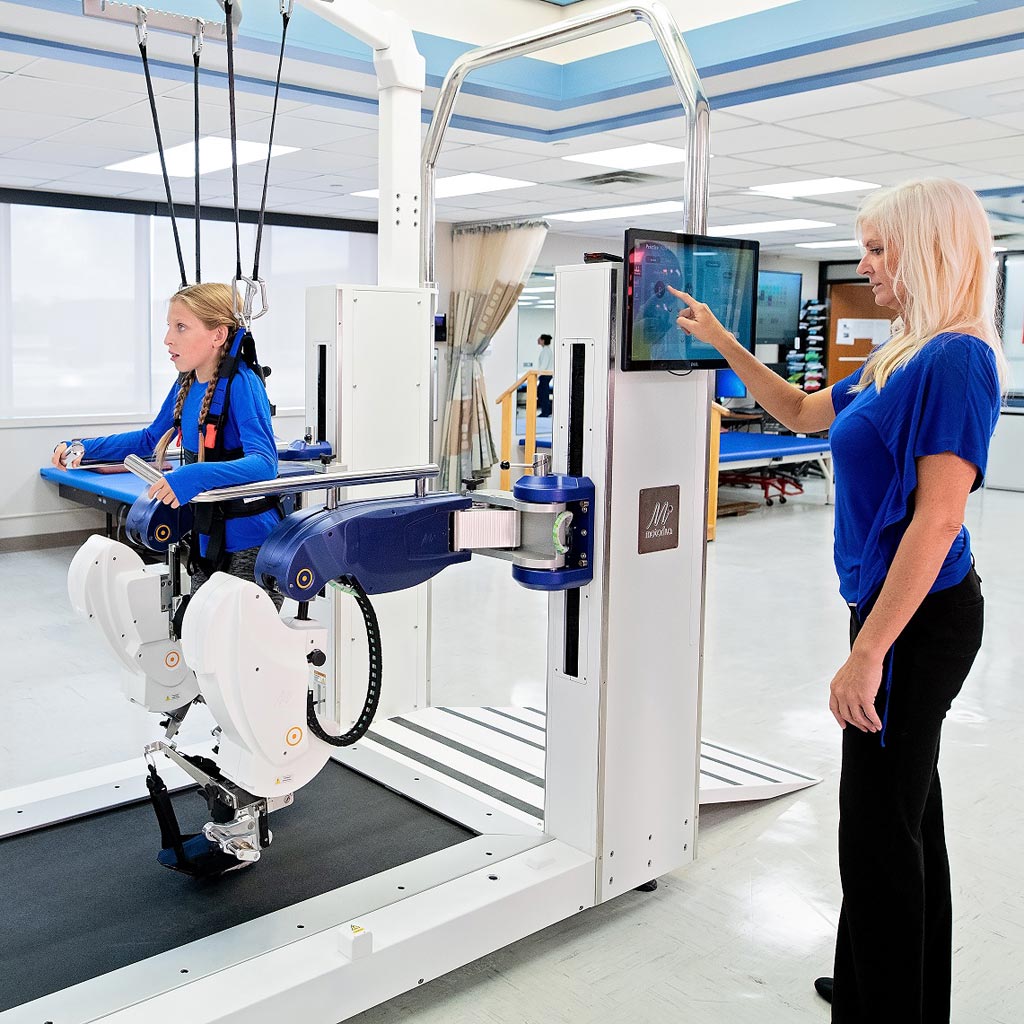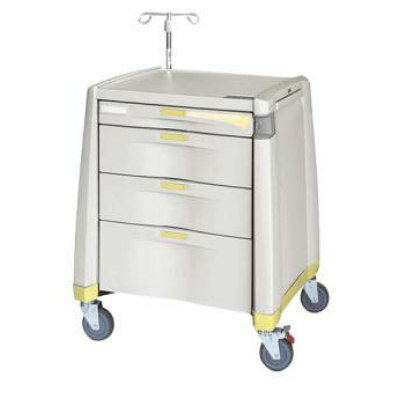Personalized Robotic Platform Rehabilitates Disorganized Gait
|
By HospiMedica International staff writers Posted on 06 Feb 2019 |

Image: The Optimal-G Pro personalized gait platform (Photo courtesy of Motorika).
An advanced gait rehabilitation system uses enhanced learning intelligence technology (ELITE) to provide optimal neuromuscular re-education and brain retraining.
The Motorika (Mount Laurel, NJ, USA) Optimal-G Pro system integrates clinical principles of gait rehabilitation and motor learning with expertise in robotic technology to restore natural physiological gait patterns in both adults and pediatric patients following neurological trauma or orthopedic injury. The system provides real-time video biofeedback through front and side cameras that offer superior visualization in order to reinforce proper gait biomechanics. ELITE proactively adjusts the patient's treatment plan, based on objective clinical data and their individual progress.
Neuromuscular re-education and brain retraining are facilitated by intensive and repetitive reciprocal motion, recovering normal gait patterns and improves ambulatory capabilities, balance, stability, and posture. By continuously analyzing functional abilities, therapists can provide recommendations and correct adjustments based on treatment parameters, enabling improved decision-making, progressing therapy programs, and enhancing patient care.
The Optimal-G Pro system is designed to allow for natural gait kinematic movements of the hip, knee, and ankle during walking by helping to provide three-dimensional (3D) freedom of movement of the pelvis, including lateral shift, rotation and up/down vectors. Optimal weight bearing and pressure distribution are provided by shifting load from the robotic support to the patient’s lower limbs, using an ergonomically designed harness and foot-lifters. In addition, the system provides muscle resistance measurement, passive, active, and active-assist modes of therapy, 18 physiological gait profiles, interactive games, and virtual reality.
“Robot rehabilitation solutions enable therapists to enhance traditional treatments. For example, they can be easily used under the supervision of one therapist, providing intensive, task-oriented gait training, as part of a set of rehabilitation tools that additionally include other non-robotic approaches,” said Arik Avni, co-CEO of Motorika. “Thanks to ELITE, the Optimal-G Pro enables rehabilitation professionals, for the first time, to offer a proactive motor learning technology that personalizes patient therapy and ultimately accelerates recovery.”
Human gait is defined as bipedal, biphasic forward propulsion of the center of gravity of the human body, in which there are alternate sinuous movements of different segments of the body with least expenditure of energy. Different gait patterns are characterized by differences in limb-movement patterns, overall velocity, forces, kinetic and potential energy cycles, and changes in the contact with the surface.
Related Links:
Motorika
The Motorika (Mount Laurel, NJ, USA) Optimal-G Pro system integrates clinical principles of gait rehabilitation and motor learning with expertise in robotic technology to restore natural physiological gait patterns in both adults and pediatric patients following neurological trauma or orthopedic injury. The system provides real-time video biofeedback through front and side cameras that offer superior visualization in order to reinforce proper gait biomechanics. ELITE proactively adjusts the patient's treatment plan, based on objective clinical data and their individual progress.
Neuromuscular re-education and brain retraining are facilitated by intensive and repetitive reciprocal motion, recovering normal gait patterns and improves ambulatory capabilities, balance, stability, and posture. By continuously analyzing functional abilities, therapists can provide recommendations and correct adjustments based on treatment parameters, enabling improved decision-making, progressing therapy programs, and enhancing patient care.
The Optimal-G Pro system is designed to allow for natural gait kinematic movements of the hip, knee, and ankle during walking by helping to provide three-dimensional (3D) freedom of movement of the pelvis, including lateral shift, rotation and up/down vectors. Optimal weight bearing and pressure distribution are provided by shifting load from the robotic support to the patient’s lower limbs, using an ergonomically designed harness and foot-lifters. In addition, the system provides muscle resistance measurement, passive, active, and active-assist modes of therapy, 18 physiological gait profiles, interactive games, and virtual reality.
“Robot rehabilitation solutions enable therapists to enhance traditional treatments. For example, they can be easily used under the supervision of one therapist, providing intensive, task-oriented gait training, as part of a set of rehabilitation tools that additionally include other non-robotic approaches,” said Arik Avni, co-CEO of Motorika. “Thanks to ELITE, the Optimal-G Pro enables rehabilitation professionals, for the first time, to offer a proactive motor learning technology that personalizes patient therapy and ultimately accelerates recovery.”
Human gait is defined as bipedal, biphasic forward propulsion of the center of gravity of the human body, in which there are alternate sinuous movements of different segments of the body with least expenditure of energy. Different gait patterns are characterized by differences in limb-movement patterns, overall velocity, forces, kinetic and potential energy cycles, and changes in the contact with the surface.
Related Links:
Motorika
Latest Patient Care News
- Revolutionary Automatic IV-Line Flushing Device to Enhance Infusion Care
- VR Training Tool Combats Contamination of Portable Medical Equipment
- Portable Biosensor Platform to Reduce Hospital-Acquired Infections
- First-Of-Its-Kind Portable Germicidal Light Technology Disinfects High-Touch Clinical Surfaces in Seconds
- Surgical Capacity Optimization Solution Helps Hospitals Boost OR Utilization

- Game-Changing Innovation in Surgical Instrument Sterilization Significantly Improves OR Throughput
- Next Gen ICU Bed to Help Address Complex Critical Care Needs
- Groundbreaking AI-Powered UV-C Disinfection Technology Redefines Infection Control Landscape
- Clean Hospitals Can Reduce Antibiotic Resistance, Save Lives
- Smart Hospital Beds Improve Accuracy of Medical Diagnosis
- New Fast Endoscope Drying System Improves Productivity and Traceability
- World’s First Automated Endoscope Cleaner Fights Antimicrobial Resistance
- Portable High-Capacity Digital Stretcher Scales Provide Precision Weighing for Patients in ER
- Portable Clinical Scale with Remote Indicator Allows for Flexible Patient Weighing Use
- Innovative and Highly Customizable Medical Carts Offer Unlimited Configuration Possibilities
- Biomolecular Wound Healing Film Adheres to Sensitive Tissue and Releases Active Ingredients
Channels
Critical Care
view channel
Wearable Patch for Early Skin Cancer Detection to Reduce Unnecessary Biopsies
Skin cancer remains one of the most dangerous and common cancers worldwide, with early detection crucial for improving survival rates. Traditional diagnostic methods—visual inspections, imaging, and biopsies—can... Read more
Pulse Oximeter Index Offers Non-Invasive Guides for Fluid Therapy
In patients with acute circulatory failure, deciding whether to administer intravenous fluids is often a life-or-death decision. Too little fluid can leave organs underperfused, while too much can cause... Read moreSurgical Techniques
view channel
Robotic Assistant Delivers Ultra-Precision Injections with Rapid Setup Times
Age-related macular degeneration (AMD) is a leading cause of blindness worldwide, affecting nearly 200 million people, a figure expected to rise to 280 million by 2040. Current treatment involves doctors... Read more
Minimally Invasive Endoscopic Surgery Improves Severe Stroke Outcomes
Intracerebral hemorrhage, a type of stroke caused by bleeding deep within the brain, remains one of the most challenging neurological emergencies to treat. Accounting for about 15% of all strokes, it carries... Read moreHealth IT
view channel
Printable Molecule-Selective Nanoparticles Enable Mass Production of Wearable Biosensors
The future of medicine is likely to focus on the personalization of healthcare—understanding exactly what an individual requires and delivering the appropriate combination of nutrients, metabolites, and... Read moreBusiness
view channel
Philips and Masimo Partner to Advance Patient Monitoring Measurement Technologies
Royal Philips (Amsterdam, Netherlands) and Masimo (Irvine, California, USA) have renewed their multi-year strategic collaboration, combining Philips’ expertise in patient monitoring with Masimo’s noninvasive... Read more
B. Braun Acquires Digital Microsurgery Company True Digital Surgery
The high-end microsurgery market in neurosurgery, spine, and ENT is undergoing a significant transformation. Traditional analog microscopes are giving way to digital exoscopes, which provide improved visualization,... Read more
CMEF 2025 to Promote Holistic and High-Quality Development of Medical and Health Industry
The 92nd China International Medical Equipment Fair (CMEF 2025) Autumn Exhibition is scheduled to be held from September 26 to 29 at the China Import and Export Fair Complex (Canton Fair Complex) in Guangzhou.... Read more
















